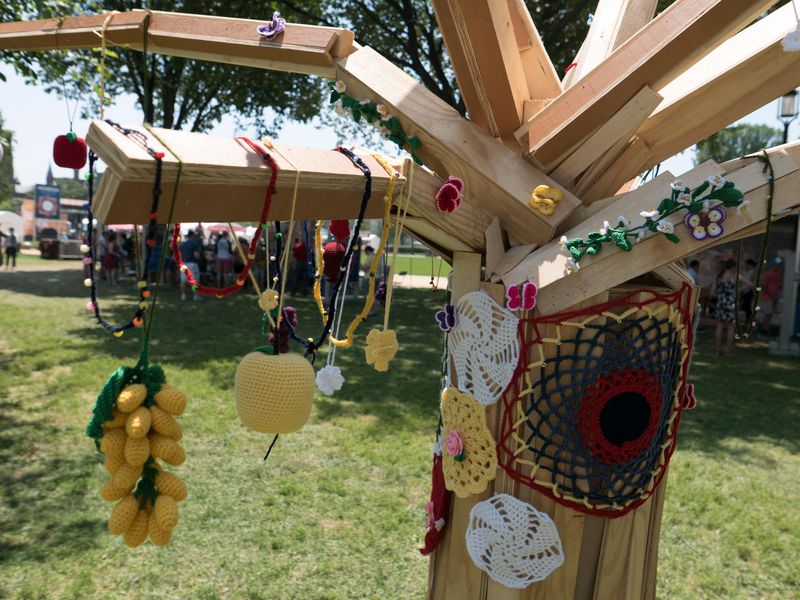Smithsonian Magazine
Armenia’s “Tree of Life” Tradition Took Root Thousands of Years Ago, and Has Only Grown Since
The tree adorned in this year’s Smithsonian Folklife Festival will continue to blossom overseas
/https://public-media.si-cdn.com/filer/84/f9/84f94b6e-9f4e-4e7c-968a-406aba6f4940/tol1.jpg)
Few images link the realms of Earth and heaven as simply or elegantly as that of a towering tree, one rooted in the mortal world yet aspiring upwards toward the firmament. The figure of a “tree of life” has long played a role in art and myth across the globe, from the vital tree at the heart of the Garden of Eden to the Bodhi Tree under which Siddhartha Gautama is said to have attained enlightenment to the ash tree bridging the nine worlds of Norse cosmology.
Armenia’s engagement with the tree of life motif runs especially deep, dating back to unrecorded time prior to the dawn of Christianity. As Armenian symbolic anthropologist Levon Abrahamian explains, sigils on ancient figurines illustrate that people from the region revered the image of the tree long before the crystallization of a coherent Armenian national identity.
Even humble kitchenware speaks to the enduring importance of the tree of life in the Armenian household. “Vessels used in the kitchen for keeping oil or other products often have a primitive tree design, symbolizing life-giving properties of the vessel,” Abrahamian says. The iconography “can be traced back as far as Armenian culture can be identified,” he asserts—“some three thousand years.”
As Christianity took hold in Armenia in the early years of the fourth century A.D.—making it the first nation to declare the young religion its official faith—the tree of life symbol evolved alongside the rest of the culture. It became intimately connected with the Christian view of human fulfillment, an exemplar of the growth and enrichment that brought one and one’s family closer to the Lord.

Not surprisingly, depictions of the tree of life can be found on the grounds of many of Armenia’s historic medieval monasteries—often in the context of khachkars, ornate crosses etched by hand in stone steles. “The Tree of Life motif frequently appears on khachkars in the form of sprouting, bursting, blooming and fruit-bearing crosses,” Abrahamian writes, and “its presence on gravestones anticipates the resurrection of those who have passed away.”
Living trees in the churchyard have also come to take on spiritual significance. “People hang pieces of their clothes or the clothes of sick relatives on the branches,” says Abrahamian, “anticipating health or curing for the people to whom those clothes belonged.” Some sacred trees in Armenia are conceptualized more broadly as “trees of wishes,” where anyone may express a sincere wish and leave a token of themselves behind.
At this year’s Smithsonian Folklife Festival, which concluded this past weekend, organizers blended the tree of life tradition with Armenia’s rich background in the art of crochet, inviting visitors to learn crochet techniques, create personalized designs, and attach them to the limbs of a wooden tree-like scaffold in a figurative and literal coming-together. This activity was made possible by donations from the Armenia Tree Project.
“It was really nice to be able to have a lot of different people interact with [the tree],” says curator Halle Butvin, who oversaw the implementation of the Armenia program on the National Mall. “By the end of the festival, it was almost completely full, and everybody was taking family pictures around it.” Butvin likened the joyous experience of adding to this tree to the whimsical practice of “yarn bombing” prevalent in the U.S. as well as parts of Yerevan.

By blending the “women’s work” of crochet with the tree of life, Butvin was also able to demonstrate the contributions of Armenian craftswomen to national and global culture. “They’re making socks, and little toys for kids—things that I don’t think get celebrated as much as stone-carved khachkars,” she says. “Being able to bring women’s work out of the home and making it on a larger scale in a public space was part of what we wanted to do—to shine a light on it.”
Levon der Bedrossian, the founder of Armenia’s community-oriented Folk Art Hubs Foundation, was delighted by the installation when he visited—and aghast when he learned it was to be dismantled at the festival’s close. Thanks to him, the Smithsonian’s now-amply decorated tree will live on in Armenia itself.
“He said, ‘Oh no, you have to send it to Armenia!’” Butvin recalls. “And he actually has a hotel there that is where the Folk Art Foundation is based, and he wants to install it in the garden of the hotel and keep adding to it.”
Like all trees of life, the Smithsonian’s humble tree has grown more and more bountiful with each day. Swathed in a handmade coat of many colors, the tree that began as a naked sculpture of wooden planks is now a living testament to the vibrancy of Armenian tradition. “It was a very simple idea,” Butvin says, “but beautifully became something much larger.”
Source: https://www.smithsonianmag.com/smithsonian-institution/armenias-tree-life-tradition-took-root-thousands-years-ago-and-has-only-grown-180969609/










